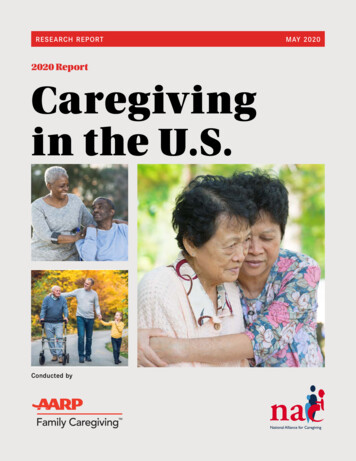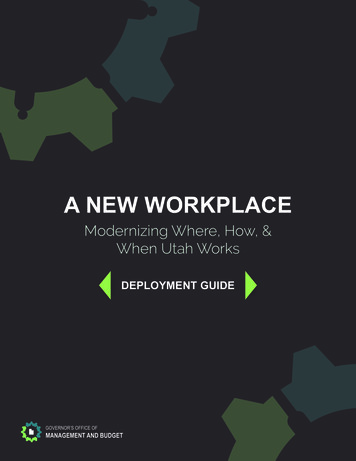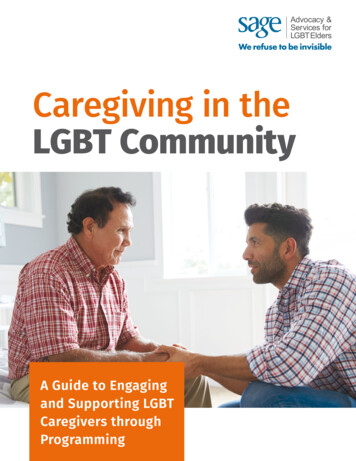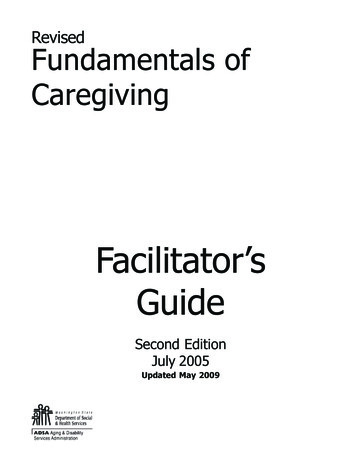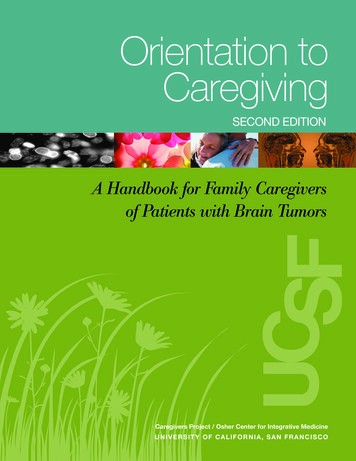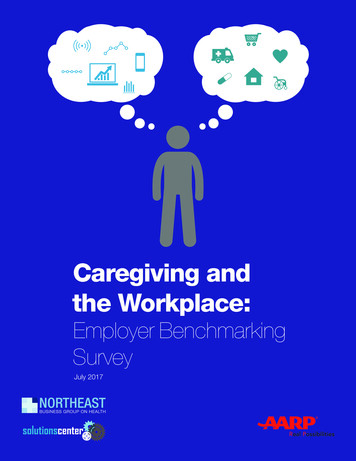
Transcription
Caregiving andthe Workplace:Employer BenchmarkingSurveyJuly 2017
2
IntroductionNortheast Business Group on Health (NEBGH) and AARP began a collaboration in late2016 designed to assess employer interest in caregiving; understand the facts, challengesand opportunities that exist for employers in addressing caregiving among employees andtheir loved ones; and identify current and emerging practices and perspectives amongemployers when it comes to developing policies, programs and services designed tosupport caregivers. An employer roundtable was held in December 2016 to commencethis project, and an initial report was released in March 2017 that highlighted the burdenof caregiving for employers and provided a sampling of benefits, policies and services thatvarious employers have implemented to support employees who are caregivers.With support from AARP, NEBGH undertook a survey in June 2017 designed to gaugeawareness and attitudes about caregiving as an issue for employers and their employees;gather more detailed information about the kinds of leave policies, benefits and programsemployers have put in place to support caregivers; and understand the barriers thatprevent organizations from becoming more “caregiver friendly.” The survey also asks aboutfactors that would make a compelling case for investment in supporting caregivers, andwhat tops employers’ wish lists in terms of what they’d like to put in place if they could.NEBGH surveyed benefits managers from 129 mostly large U.S. employers, including 40employers headquartered in or near New York City, and an additional 89 from the Midwest,Florida and California, and in the Dallas/Ft. Worth, Houston and Memphis areas. Employersnot included in this survey can use it to understand how other employers are thinkingabout the issue of caregiving, and as a reference tool for assessing what they have in placeto support caregivers as compared with what other employers are doing.3
What is your role in your organization?1%1%1%10%Percent6%Benefits ProfessionalC-suite/Exec6%Talent Recruitment and Management1%Employee Assistance Program1%Employee Leave Specialist1%Other81%81%10%How many employees does your company have?5%12%3%2%Percent19%31%16%Under 1005%101 - 5003%501 - 1,0002%1,001 - 5,00031%5,001 - 10,00012%10,001 - 20,00016%20,001 - 50,00019%Over 50,00012%12%Industry TypePercentProfessional e/Banking7%Agriculture and mer Packaged Goods8%Transportation5%Utilities0%Other46%
Our current workplace culture is "caregiving friendly"16%18%PercentStrongly Agree18%Agree66%Disagree16%Strongly Disagree0%66%During the next five years, caregiving will become an increasingly important issue to our company16%26%PercentStrongly Agree26%Agree58%Disagree16%Strongly Disagree0%58%Please characterize where caregiving falls within your priorities for employees health and benefitissues11%12%Percent32%Top 5 priorities12%Top 1045%Aware, but unable to address it32%Not on my radar11%45%5
AWARENESS OF CAREGIVING:Please select the degree to which you agree or disagree with the following statements ingeneral:There are benefits, programs and policies that can make the workplace more caregiving friendly5%2%30%Percent63%Strongly Agree30%Agree63%Disagree2%Strongly Disagree0%Not Sure5%Caregiving is a driver of presenteeism and absenteeism1% 2%Percent40%57%Strongly Agree40%Agree57%Disagree1%Strongly Disagree0%Not Sure2%Caregivers are more likely than non-caregivers to abandon self care15%1%35%6%PercentStrongly Agree35%Agree43%Disagree6%Strongly Disagree1%Not Sure43%615%
Supporting caregiving will increase workforce productivity11%2%Percent37%Strongly Agree37%Agree50%Disagree2%Strongly Disagree0%Not Sure50%11%It is common for employees to spend up to 20 hrs/week in a caregiving role14%Percent38%40%Strongly Agree14%Agree40%Disagree7%Strongly Disagree1%Not Sure38%1%7%Millennials are 25% of caregivers in the US; knowing this my company will offer more caregivingbenefits6%Percent32%Strongly AgreeAgree50%Disagree12%Strongly Disagree50%6%Not Sure0%32%12%7
THE CULTURE OF CAREGIVING IN YOUR WORKPLACE:Please select the degree to which you agree or disagree with the following statements asthey pertain to your workplace (if applicable):The benefits department works closely with employee assistance programs (EAP) or work-lifeprograms to support caregivers2%5%18%Percent23%52%Strongly Agree18%Agree52%Disagree23%Strongly Disagree2%Not Sure5%Employees are comfortable identifying their caregiver status to managers and colleagues5%Percent34%31%Strongly Agree5%Agree31%Disagree27%Strongly DisagreeNot Sure3%34%3%27%Being a more "caregiving-friendly"workplace would attract and retain talent22%20%Percent3%Strongly Agree20%Agree55%Disagree3%Strongly Disagree0%Not Sure55%822%
Being identified as a "caregiving-friendly" workplace is important to our company14%23%Percent48%15%Strongly Agree14%Agree48%Disagree15%Strongly DisagreeNot Sure0%23%Being a more "caregiving-friendly" workplace is a high priority for my role as a benefits professional13%14%3%Percent35%35%Strongly Agree14%Agree35%Disagree35%Strongly DisagreeNot Sure3%13%The C-suite will support caregiving friendly policies13%Percent37%38%Strongly Agree13%Agree38%Disagree12%Strongly DisagreeNot Sure0%37%12%Developing a business case with specific Return on Investment (ROI). is necessary to implementnew caregiving benefits, programs and policies1%14%6%25%PercentStrongly Agree25%Agree54%Disagree14%Strongly Disagree1%Not Sure6%54%9
Leave Policies: Which of the following policies are currently available to employees at yourworkplace? (Check all that apply)# of ResponsesPaid leave exclusively for caregiving (separate from parental leave)14Paid leave which can be used for parental or caregiving29Paid Family Medical Leave37Sick, vacation or personal days which can be used for self care or another105Family Medical Leave application guidance95Flexible work schedules74Employees can "donate" leave time to their colleagues21Caregiving policies that may be extended to care for friends (not only family)None of the above10Other7How many hours per year of paid caregiving leave (or other leave types that may be used for caregiving) do employees have access to?Percent7%34%None4%Less than 40 hrs (1 week)7%34%11%12%8%17%8%40 - 79 hrs (1 week to less than 2 weeks)17%80 - 119 hrs (2 weeks to less than 3 weeks)12%120 - 159 hrs (3 weeks to less than 4)11%160 - 239 hrs (4 weeks to less than 6)7%240 - 319 hrs (6 weeks to less than 8)4%320 - 399 hrs (8 weeks to less than 10)0%400 - 479 hrs (10 weeks to less than 12)0%480 hrs or more (12 weeks or more)7%Direct Support for Caregivers: Which of the following benefits, programs or policies arecurrently available to employees at your workplace? (Check all that apply)# of Responses100Employee Assistance Program (EAP) and/or Work-life ProgramEAP and/or Work-life Program w/ services specific to caregivers43Employee caregiver support, affinity or employee resource groups24Counseling, coaching or wellness programs specific to supporting caregiversthemselves33Subsidized in-home back-up care, such as Bright Horizons31Access to free/low-cost resources to support caregiversNone of the above10252
Access to Benefits for Employee Caregivers and Those Being Cared For: Which of thefollowing benefits, programs or policies are currently available to employees at your workplace?(Check all that apply)# of ResponsesHelp navigating healthcare system available to employees andnon-dependent family members35Expert medical opinion and referral serviceEmployer-subsidized memberships to caregiving resourcessuch as Care.com2316None of the above60How aware are the employees at your company of employee benefits of caregiving? Please choosethe most accurate option.5%6%9%PercentVery39%6%Somewhat39%Not very41%Not at all9%Not applicable5%41%Are access and information about caregiving benefits integrated (i.e. on an an intranet pagecombined with health benefits) and communicated with traditional employees health benefits?8%Percent42%50%Yes50%No42%Not applicable8%11
In your opinion, what are the greatest barriers preventing a workplace from being "caregivingfriendly"?OverallRankItem1Absence of employer benchmarks and best practices for caregiving2Lack of financial resources3Lack of data to identify caregivers4Insufficient organizational capacity to support leave or flexible schedules5Lack of engagement with caregiving support6Difficulty getting buy-in from senior leadership7Cannot manage additional vendors to provide caregiving services7Negative stigma towards caregiving9OtherWhat are the greatest drivers that would make a compelling case for investment in "caregivingfriendly" benefits, programs and resources?OverallRankItem1Increase in productivity2Decrease in absenteeism3Reduced health care costs4Recruiting and retaining talent5Emotional impact, anecdotal evidence or stories of employee caregiversAre Family Responsibility Discrimination (FRD) regulations a concern for your workplace?6%27%67%12PercentYes6%No27%Not applicable67%
The market for digital caregiving support tools and digital-enabled support servicesis growing.YesNoDo you offer any of these programs toemployees?If not, would you be interested inproviding these tools to employees?11%15%85%89%Would you feel confident in choosing theright tools for your employee population?57%Would you remain interested in suchtools if there were a price tag attached?35%65%43%13
Your caregiving wishlist: Regardless of any other constraints, if you could implement two newpolicies, programs or benefits tomorrow to support caregivers, which would you choose? (Chooseonly two)# of ResponsesExpanded leave policies59Subsidized access to digital tools or other caregiving resources37Expanded access to ancillary benefits for non-dependents24Flexbile work arrangements37Coaching, wellness, or support services specific to caregivers to care forthemselvesOther541How do you think your company measures up against other similar employers as "caregivingfriendly"?13%22%PercentAbove average22%Average65%Below average13%65%What resources, guides or toolkits would be most helpful to you as a benefits professional whenconsidering caregiving benefits, programs and policies? (Check all that apply)# of ResponsesEmployer best practices91Practical guide for being a "caregiving-friendly" workplace—tips for businessesof various size and industry86Fact sheet and resources to provide to employeesOther14752
About NEBGHNortheast Business Group on Health (NEBGH) is an employer-led coalition ofhealthcare leaders and other stakeholders that empowers its members to driveexcellence in health and achieve the highest value in healthcare delivery and theconsumer experience.About NEBGH’sSolutions CenterThe Solutions Center is NEBGH’s unique data-gathering and discovery platformfor developing initiatives that can “move the needle” when it comes to criticalhealthcare issues. Focused on employers as a catalyst for change, the SolutionsCenter’s mission is to identify the most promising, innovative opportunitiesfor improving health outcomes, and create a framework with the potential fortransforming results and changing the national dialogue.About AARPAARP is the nation’s largest nonprofit, nonpartisan organization dedicated toempowering Americans 50 and older to choose how they live as they age. Withnearly 38 million members and offices in every state, the District of Columbia,Puerto Rico, and the U.S. Virgin Islands, AARP works to strengthen communitiesand advocate for what matters most to families with a focus on health security,financial stability and personal fulfillment. AARP also works for individualsin the marketplace by sparking new solutions and allowing carefully chosen,high-quality products and services to carry the AARP name. As a trusted sourcefor news and information, AARP produces the nation's largest circulationpublications, AARP The Magazine and AARP Bulletin. To learn more, visitwww.aarp.org/caregiving, www.aarp.org or follow @AARP and @AARPadvocateson social media.15
16
2016 designed to assess employer interest in caregiving; understand the facts, challenges . Florida and California, and in the Dallas/Ft. Worth, Houston and Memphis areas. Employers . Being a more "caregiving-friendly" workplace is a high priority for my role as a benefits professional 35% 3% 13% 35% 14% The C-suite will support caregiving .


